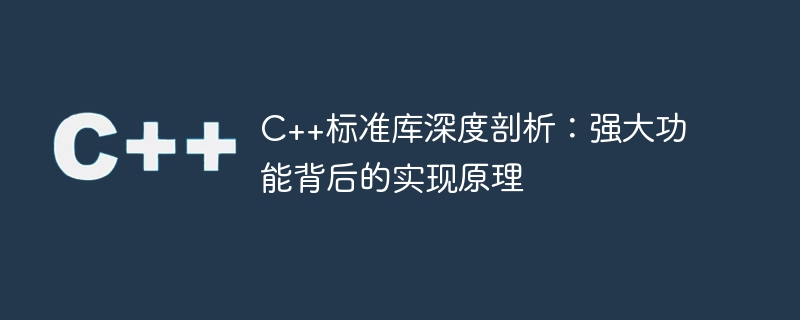

The C standard library is one of the core components of the C language. It provides a wealth of functions and tools to help developers program more efficiently. The C standard library contains many classes and functions, such as algorithms, containers, iterators, IO streams, etc. The implementation behind these tools is quite complex. This article will take the C standard library as an example to deeply explore the implementation principles of some of these powerful functions.
1. Container
The container in the C standard library is one of its most commonly used components. The most popular containers include vector, list, set, and map. These containers have different properties and uses, but they all use iterators from the standard library to achieve their basic functions.
Iterator is a core concept in the C standard library. It is responsible for traversing the elements in the container and provides some APIs to access the elements of the container. The elements in the container can be accessed through the iterator's begin() method, and the last element can be accessed through the end() method. These containers are implemented using random access iterators, which allows them to access their elements as efficiently as arrays.
In addition to random access iterators, there are a variety of iterators in the C standard library, such as forward iterators and bidirectional iterators. The most commonly used of these iterators are bidirectional iterators, which provide the ability to traverse a container in reverse. The set and map containers of the C standard library are implemented using bidirectional iterators.
The implementation principle of containers involves many algorithms and data structures, such as red-black trees and binary heaps. These data structures have excellent time and space complexity and can effectively improve the performance of the container. Therefore, although the containers in the C standard library seem simple, their implementation behind the scenes is very complex.
2. Algorithm
The algorithm in the C standard library is another very important component. They can help developers quickly implement various common algorithms, such as sorting, searching, finding, filling, etc.
Every algorithm in the C standard library is implemented through iterators. Each algorithm uses a different type of iterator, so the same algorithm may be implemented differently in different types of containers. For example, sorting algorithms require the container to provide random access iterators, while search algorithms only require bidirectional iterators.
In addition, the algorithms in the C standard library also make full use of features such as function objects and lambda expressions. Function objects are objects that can be called like functions. They support features such as function overloading and template functions. Lambda expressions can help developers implement some simple function objects more conveniently. These features greatly enhance the flexibility and reusability of algorithms in the C standard library.
3. IO stream
IO stream is another important component in the C standard library. They support reading data from and writing data to external devices. These external devices can be files, screens, keyboards, etc.
The most basic class in IO stream is the iostream class, which provides basic input and output operations. The iostream class is also the basis for other IO stream classes. In addition to the iostream class, there are also classes such as ifstream, ofstream, and fstream in the C standard library, which are used to read files, write files, and read and write files respectively.
The most important part of these IO streams is their buffer. All streams in the C standard library contain a buffer for buffering data. When we read data from a stream, the data is first read into a buffer. We can view the data in the buffer and clear it if needed. When we write data to the stream, the data will also be written to the buffer and automatically refreshed to the external device under certain conditions. The concept and implementation of these buffers are very complex and involve many underlying operations and algorithms.
Summary
The C standard library is a core component of the C language, which contains a wealth of functions and tools, such as containers, algorithms, IO streams, etc. The implementation of these components involves numerous algorithms and data structures, and various iterators are also key concepts. In addition, features such as function objects and lambda expressions also provide greater flexibility and readability for the implementation of the C standard library.
Although the C standard library seems simple, the implementation principles behind it are quite complicated. An in-depth grasp of the implementation principles of the C standard library will help us better understand the C language and help us program more efficiently.
The above is the detailed content of In-depth analysis of the C++ standard library: the implementation principles behind the powerful functions. For more information, please follow other related articles on the PHP Chinese website!




